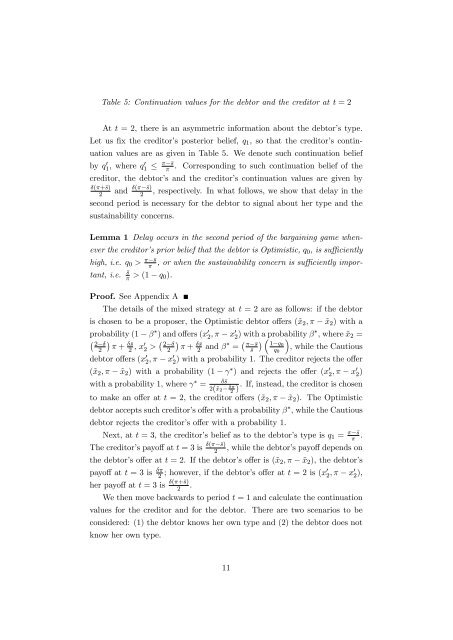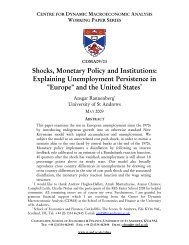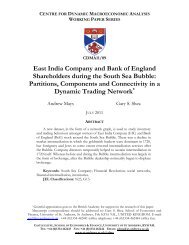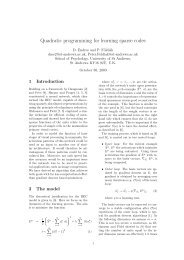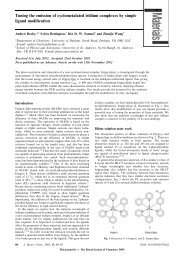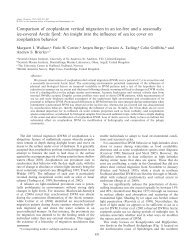Delay and Haircuts in Sovereign Debt - University of St Andrews
Delay and Haircuts in Sovereign Debt - University of St Andrews
Delay and Haircuts in Sovereign Debt - University of St Andrews
You also want an ePaper? Increase the reach of your titles
YUMPU automatically turns print PDFs into web optimized ePapers that Google loves.
Table 5: Cont<strong>in</strong>uation values for the debtor <strong>and</strong> the creditor at t = 2<br />
At t = 2, there is an asymmetric <strong>in</strong>formation about the debtor’s type.<br />
Let us …x the creditor’s posterior belief, q 1 , so that the creditor’s cont<strong>in</strong>uation<br />
values are as given <strong>in</strong> Table 5. We denote such cont<strong>in</strong>uation belief<br />
by q1 0 , where q0 1 s . Correspond<strong>in</strong>g to such cont<strong>in</strong>uation belief <strong>of</strong> the<br />
<br />
creditor, the debtor’s <strong>and</strong> the creditor’s cont<strong>in</strong>uation values are given by<br />
(+s) ( s)<br />
2<br />
<strong>and</strong><br />
2<br />
, respectively. In what follows, we show that delay <strong>in</strong> the<br />
second period is necessary for the debtor to signal about her type <strong>and</strong> the<br />
susta<strong>in</strong>ability concerns.<br />
Lemma 1 <strong>Delay</strong> occurs <strong>in</strong> the second period <strong>of</strong> the barga<strong>in</strong><strong>in</strong>g game whenever<br />
the creditor’s prior belief that the debtor is Optimistic, q 0 , is su¢ ciently<br />
high, i.e. q 0 > s<br />
<br />
, or when the susta<strong>in</strong>ability concern is su¢ ciently important,<br />
i.e.<br />
s<br />
> (1 q 0).<br />
Pro<strong>of</strong>. See Appendix A<br />
The details <strong>of</strong> the mixed strategy at t = 2 are as follows: if the debtor<br />
is chosen to be a proposer, the Optimistic debtor o¤ers (~x 2 ; <br />
~x 2 ) with a<br />
probability (1 ) <strong>and</strong> o¤ers (x 0 2 ; x0 2 ) with a probability , where ~x 2 =<br />
<br />
2 <br />
2 +<br />
s<br />
2 , x0 2 > 2 <br />
2 +<br />
s<br />
2 <strong>and</strong> = s 1 q 0<br />
s q 0<br />
, while the Cautious<br />
debtor o¤ers (x 0 2 ; ) with a probability 1. The creditor rejects the o¤er<br />
x0 2<br />
(~x 2 ; ~x 2 ) with a probability (1 ) <strong>and</strong> rejects the o¤er (x 0 2 ; x0 2 )<br />
with a probability 1, where =<br />
s<br />
<br />
2(~x 2 2 )<br />
to make an o¤er at t = 2, the creditor o¤ers (~x 2 ; <br />
. If, <strong>in</strong>stead, the creditor is chosen<br />
~x 2 ). The Optimistic<br />
debtor accepts such creditor’s o¤er with a probability , while the Cautious<br />
debtor rejects the creditor’s o¤er with a probability 1.<br />
Next, at t = 3, the creditor’s belief as to the debtor’s type is q 1 = <br />
s<br />
.<br />
The creditor’s payo¤ at t = 3 is ( s)<br />
2<br />
, while the debtor’s payo¤ depends on<br />
the debtor’s o¤er at t = 2. If the debtor’s o¤er is (~x 2 ; ~x 2 ), the debtor’s<br />
payo¤ at t = 3 is 2 ; however, if the debtor’s o¤er at t = 2 is (x0 2 ; x0 2 ),<br />
her payo¤ at t = 3 is (+s)<br />
2<br />
.<br />
We then move backwards to period t = 1 <strong>and</strong> calculate the cont<strong>in</strong>uation<br />
values for the creditor <strong>and</strong> for the debtor. There are two scenarios to be<br />
considered: (1) the debtor knows her own type <strong>and</strong> (2) the debtor does not<br />
know her own type.<br />
11


